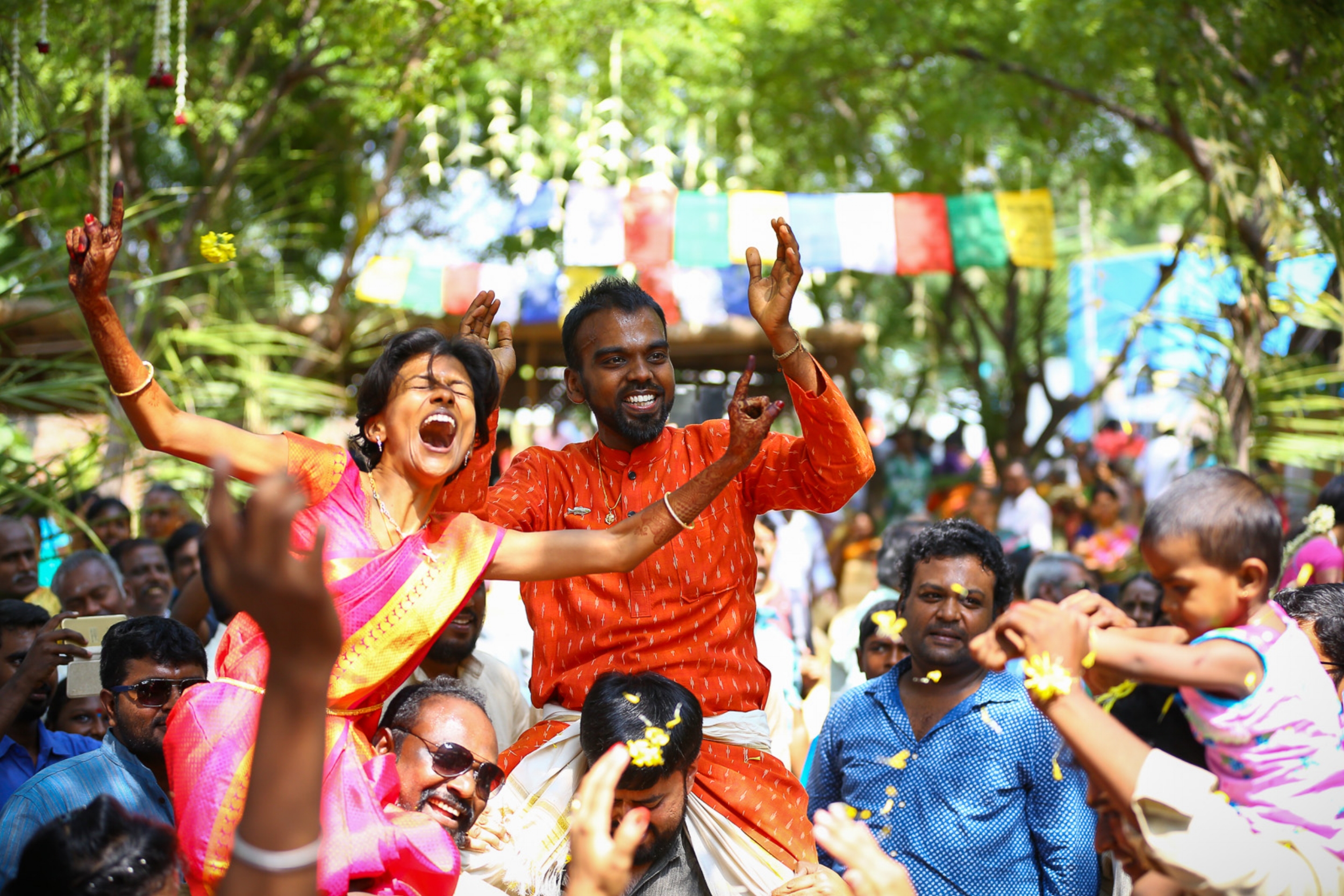Asana-Bhakti-Ecology: Lessons for sustainable living from yoga at Govardhan Eco Village

(Note: This is a sequel to an earlier article titled ‘Bhakti-Yoga-Ecology - Lessons for Environmental Consciousness from Yoga at Govardhan Eco Village'. Read Part 1 here).
Yoga literally means to unite in Sanskrit. It is a holistic combination of sustainable lifestyle practices with the objective of cleansing and maintaining our physical, mental, and spiritual health. A yogic lifestyle is practised in unity and harmony with oneself, nature, society, and God.
Radhanath Swami, a monk in a Krishna-bhakti lineage and teacher of the devotional path of Bhakti-yoga, is the visionary behind Govardhan Eco Village, in the Wada taluk of the Palghar district in Maharashtra. The eco- village is a retreat centre offering a holistic experience of social, ecological and spiritual living, located at the foothills of the Sahyadhri Mountains, about 108km north of Mumbai, India. It is based on the profound yet humble principle of ‘simple living and high thinking.’ According to Radhanath Swami,
“If we have unity, we can create unity. If our mind is not balanced with our body and with the needs of the soul, then there is a fundamental disunity in our life. When there are so many dysfunctional people and they are not in harmony with their own consciousness; if their mind, body and soul are not in one interest, in purpose, if they are not unified, then there can be no real peace, there can be no real happiness, there can be no real love.”
The focus of this article is on a particular facet of yoga – the asanas or yoga postures as a part of the Hatha yoga system and its interrelationship with sustainable living.
Asana-Bhakti
Asanas are the physical yoga postures as a part of the hatha yoga system. The system of hatha yoga was designed to transform the body to be able to receive and sustain higher levels of energy. It regulates the body’s secretions, hormones, breath, and brain waves to harmonise the body and mind. It is a means to make the body and mind supple enough to effortlessly handle day-to-day physical and mental exertions. Therefore, the output of yoga is not to become muscular but to have a flexible enough body and mind to easily go about one’s daily activities.
Asanas are unique from other forms of physical exercises as they focus on placing the physical body in various positions with awareness, relaxation and concentration. Even the simplest asanas can have a profound beneficial overall effect, especially as a part of the body-mind connection. While the body and mind are often regarded as separate entities, yoga and the practise of asanas integrates and harmonises the two.
Often, people take to yoga for physical health, to reduce stress or to be fit. While physical and mental health is the natural consequence of practising yoga, its goal is more far-reaching. Yoga is about harmonising oneself with the universe to achieve the highest level of perception and harmony. Radhanath Swami illuminates this with an interesting real life story. There was a lady he knew who started practising yoga for physical fitness and to become beautiful. She wasn’t particularly interested in the spiritual or ‘bhakti’ aspect of it. After doing asanas, pranayama and the entire hatha yoga system and as the years went by, her mind became balanced and calm. Soon, in her calm and balanced state of mind she genuinely wanted a deeper spiritual experience and started taking the ‘bhakti’ aspect very seriously. Radhanath Swami summarises this by explaining, “The hatha yoga system is like a ladder with different stages that eventually brings us to the highest rung to realise the divinity within us. We then perceive sacredness in every being and in everything.”
Asana-Ecology
Interestingly, most asanas are named after flora, fauna and nature or are associated with sustainable agricultural practices, constantly reminding us of our connection with mother earth.
The implication of the animal inspired asanas is quite interesting. Most animal and bird asanas are the resting poses of the animals. They do not rest horizontally like we do, and the asanas mimic their resting or standing poses. This reiterates that asanas are not meant to be strenuous exercises but are recreational poses to refresh a tired body, keep it fit and active, and develop steadiness of both the body and mind.
The following is a partial and indicative list of nature and living off the land inspired asanas:
Nature-inspired: Tadasana (mountain pose), Vajrasana (thunderbolt pose), Vrikshasana (tree pose), Bhu namanasan (Earth worship pose), Shavasana (corpse pose).
Animal-inspired: Titaliasana (butterfly pose), Kakasana (crow pose), Vrscikasana (scorpion pose), Kapotasana (pigeon pose), Kukkutasana (rooster pose).
Agriculture-inspired: Chakrasana (wheel pose), Chakkichalanasan (grinding flour on the hand mill), Kashtha Takshanasana (chopping wood), Halasana (plough pose), Rajjukarshanasan (pulling rope).
Body movement-inspired: Hasta Sanchalan (arm movements), Pada Sanchalan (leg movements), Janu Sanchalan (knee movements), Skandha Sanchalan (shoulder movements), Kantha Sanchalan (neck movements).
The above list is small and indicative. The entire list of yoga asanas are quite exhaustive and are either nature inspired or based on activities related to our body movements and living off the land.
Asanas prepare our body and mind for the next level of yoga. They also have incidental benefits such as physical fitness, increased body flexibility, and hormonal balance. In turn, this results in a sharp, balanced, and calm mind. Such a state of mind opens up to spirituality which in turn makes us compassionate towards all living beings and nature.
Asana-Bhakti-Ecology
Socio-environmental issues are of utmost concern in present times. After colonialism, the industrial revolution, capitalism and in the current neo-liberal era, the progress of a country and society is measured only on the basis of its gross domestic product (GDP) and profits. It does not take into consideration environmental and social aspects, making this kind of development unsustainable and lopsided. More GDP and more profits mean plundering and exploitation of natural resources globally without giving back to mother earth, or simply put when development is driven by greed. Mahatma Gandhi once said, “The earth provides enough to satisfy every man's needs, but not every man's greed.” Radhanath Swami, while explaining the root cause of pollution, says,
“It is the pollution in the ecology of the human heart that is the root cause of today’s socio-environmental issues.” He further elaborates on how people’s hearts are polluted by toxic greed and egotism, which is intoxicating. He says, “The more it gets, the more it needs; it hardens the heart, justifies cruelty, induces envy, divides families, and provokes wars.”
Radhanath Swami focusses on yoga as a medium towards sustainable living. He says, “Yoga is the science of cleansing the heart and tasting the joy of living in harmony with god, with all other living beings and with nature.” He further elaborates, “There is a law of environmental economics where what we take, we must return, and what we return is what is going to come back to us. We exploit and take so much goodness from mother earth and return toxic waste into her and hence, in the long run, it is that very toxic waste that will come back to us and destroy us.” Yoga is meant to bring about from within our own hearts genuine compassion and love for the well-being of other living beings. This is the greatest need in human society.
Yoga Course at Govardhan Eco Village
Govardhan Eco Village hosts, facilitates and conducts a twenty eight day, residential Certified Yoga Teacher Training Course as well as one week and shorter introductory courses as a part of the Govardhan School of Yoga. The teachers are a practising yoga couple from Nashik from the Yoga Vidya Gurukul and specialise in hatha and astanga-yoga along with seasoned bhakti-yoga monks residing in the eco village. The courses are based on the tenets of an amalgamation of bhakti, yoga and ecology, in sync with the eco village principle of ‘simple living and high thinking’. They are holistically designed, taking into consideration all facets of sustainable living, namely, social, environmental and spiritual.
The eco village is an ideal locale for the yoga course with its focus on holistic living which includes sustainable Vedic farming practices, animal care and protection, green buildings, ayurvedic wellness centre, water conservation, soil biotechnology, waste management, rural empowerment and education, encouragement of local arts and handicrafts and a plant nursery with indigenous varieties of flora.
The prerequisite for signing up for the teacher’s training course is as humble as its principle of ‘simple living and high thinking’. It reads as follows:
‘An open heart with self-motivation for learning would help achieve the objective of the course. Participants need not be yoga teachers or experts — only your sincere desire and commitment for self-improvement is needed. Even if you are not interested in teaching, you are still welcome to experience the ashram and yogic lifestyle for your overall well-being.’
For more details and upcoming yoga courses at GEV, visit their website.
Maya Ganesh is a socio-environmental researcher, educator, writer, consultant and natural farming practitioner, with an interest in community-driven sustainable initiatives, closed loop systems, rural-urban linkages, children and the environment, and spiritual ecology. She can be reached on mayaganesh74 (at) gmail (dot) com.









